This focuses on effectiveness or performance of the organization as a whole. Effectiveness or performance of an organization as a whole may depend on various factors e.g. role in social responsibility, corporate image, and business portfolio. Business portfolio i.e. the combination of businesses owned by an organization, most determines the organization‘s performance. The performance most depends on whether the businesses are good and whether the organization is strong in them. How good a business is and how strong an organization is in the business determines the attractiveness of the business. An organization should allocate resources to
businesses according to attractiveness i.e. the more the attractiveness the more the resources allocated. The amount of resources allocated to a business determines the size of the business.
Business portfolio reflects how an organization has allocated its resources among various businesses. How well such resources have been allocated or utilized determines the organization‘s performance. Performance is seriously compromised if resource allocation or
utilization violates the criterion of attractiveness e.g. allocating large resources to unattractive businesses at the expense of attractive ones. Portfolio analysis, therefore, plays a very important role in corporate strategic analysis and choice.
Business Portfolio Analysis decisions
This essentially should incorporate current as well potential businesses. The analysis should address the following two issues:
- What businesses will the organization be in?
- How will the organization allocate its resources among the businesses?
These two issues give rise to the following fundamental strategy challenges:
- How attractive is the group of businesses the organization is in?
- If the organization retains its current businesses, how good is its performance outlook in the future?
- How can the organization strengthen its business portfolio?
Models of Portfolio Analysis
Business portfolio models or matrices are a technique for categorizing businesses and ranking them on the basis of attractiveness. Portfolio analysis enables the organization to identify the strategic options that can help in strengthening its business portfolio in order to enhance performance. The following matrices are among the most popularly used portfolio models.
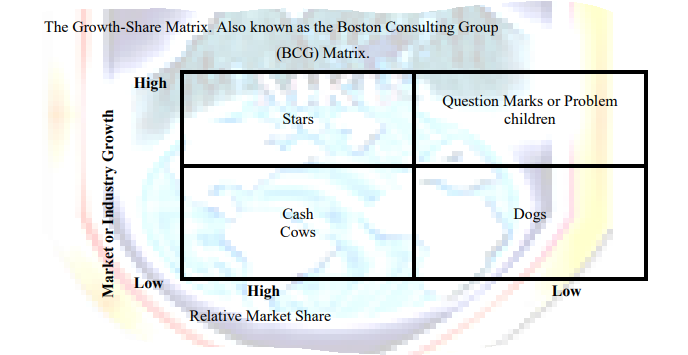
- Market or industry growth refers to the rate at which industry sales are growing.
- Relative market share refers to the ratio of the organization‘s market share to that of the biggest rival in the industry.
- In this 2 x 2 matrix, various businesses are plotted accordingly depending on their market growth and the organization‘s relative market share
Which categories of businesses as represented by quadrants of the matrix, would require the following strategies?
Investment
Divestment
Liquidation
Growth
Joint venture
Strategic alliances
The matrix suggests the following strategy prescriptions or options:
Stars
- Best businesses in portfolio
- Strong businesses in good markets
- Businesses generating and using a lot of cash
- Strategy should defend and grow such businesses
Question Marks
- Heavy net cash users
- Need cash from other businesses
- Today‘s question marks are likely to be tomorrow‘s stars
- These businesses need investment and growth strategies
Cash cows
- Cash-rich businesses
- The cash can be used to develop businesses with better future prospects e.g.
Question marks.
These businesses need strategies that will maintain them so that the organization can continue to ‗milk‘ them for cash.
Dogs
- Weak businesses in low growth markets.
- Such businesses need strategies that will drain them for cash.
- Eventually divestment and liquidation strategies are needed.
- Proceeds of liquidation may be used for strengthening other businesses.
The strategies that will be considered by the organization will depend on the strategic objectives to be achieved or the opportunities, threats, strengths and weaknesses of the organization.
For example:
Question marks
- The opportunity to be exploited is high market growth rate for such businesses.
- The weakness confronting the firm is low market share.
- Such businesses can be turned into stars by enhancing the organization‘s market share (possible strategic objective).
- One or more of the following are possible strategies:
Improving professional skills of sales force.
More aggressive advertising.
Improving the product.
Motivating channel members
Changing pricing strategy
The entire portfolio should be in cash balance i.e. the need to balance between the cash generated and cash used.
Market Attractiveness – Business Strength Matrix. Also known by the following names:
- General Electric Matrix
- McKinsey Matrix
- 3 x 3 Matrix
- Nine Cell Matrix
- Multi-factor Matrix
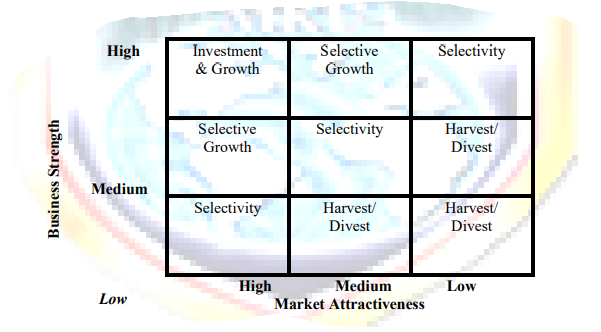
The logic behind this matrix and the application of the matrix are similar to those of the BCG.
- Unlike the market growth dimension of the BCG model, the market attractiveness dimension of the GE model is a product of many factors.
- Similarly the business strength dimension of the GE model is a product of many factors unlike the relative market share dimension of the BCG model.
- The 3 x 3 matrix produces more refined analyses than the 2 x 2 BCG matrix.
What would be the strategy prescriptions of this model?
At this point every manager is expected to undertake a business strategic analysis. The basic question here is how to succeed in the market place. A choice has to be made among various strategy options. Strategy options must be chosen that will enhance the organization‘s competitive position. Therefore strategic analysis at business level is concerned with identifying and generating strategies that can help the business to develop a solid and sustainable competitive advantage. The strategies can be identified with the help of models, the relevant models depending on the strategic objectives to be achieved.
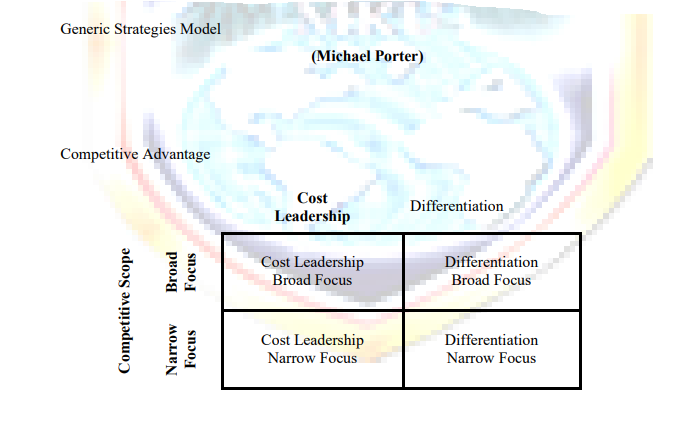
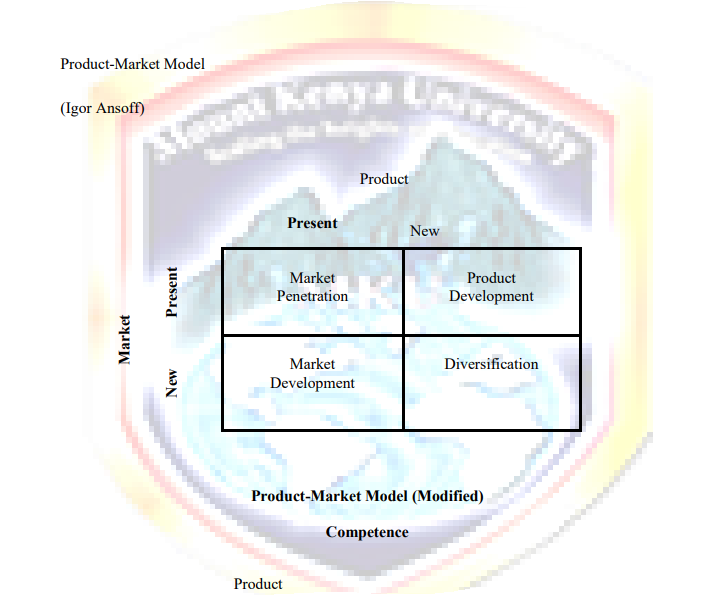
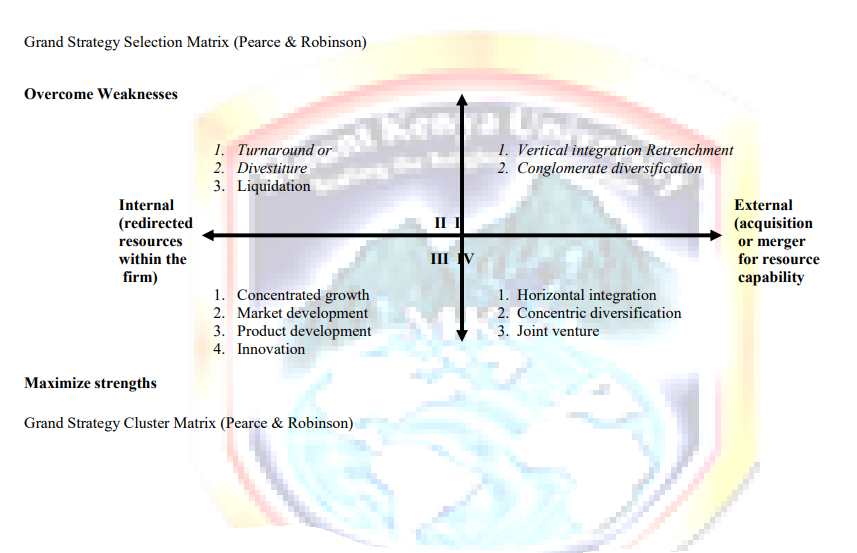
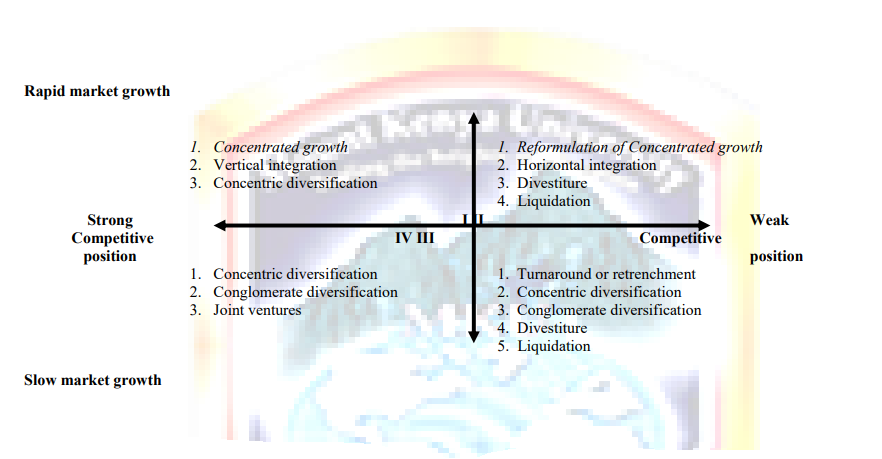
In the Strategic evaluation and choices, The strategic options generated during strategic analysis must be evaluated in order to select the best options. Strategy is aimed at achieving a firm‘s strategic objective. An objective can be achieved by doing a number of things, each being a strategy in itself. For example, British Airways‘ objective of having at least 70% of their employees professionally qualified in their jobs can be achieved through the following strategies:-
- Training employees on the job.
- Training employees off the job.
- Hiring only qualified people.
- Giving training grants or allowances to employees to enable them attend courses on their own.
- Poaching from other airlines.
The various strategy options for achieving an objective should be evaluated in order to choose the best one(s) among them. Some pertinent evaluation criteria are:
- Effectiveness in achieving the objective.
- Potential competitive advantage.
- Likely competitor responses.
- Benefits e.g. financial benefits.
- Cost
- Affordability
- Resources
- Ease of implementation
There are a number of ways the criteria can be used to evaluate strategic options. One such way is to assign weights to the criteria and compute weighted scores for the options as illustrated in the example below.
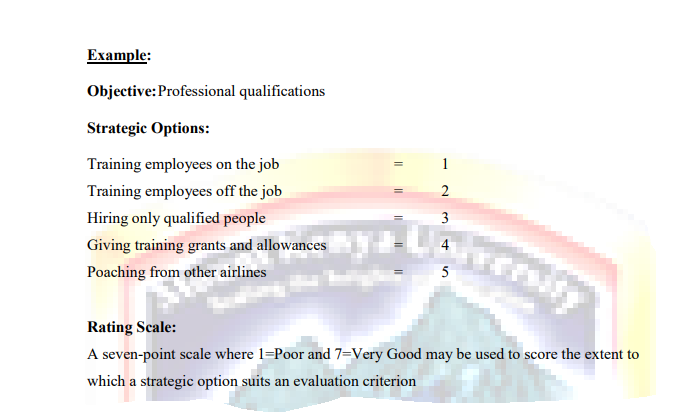
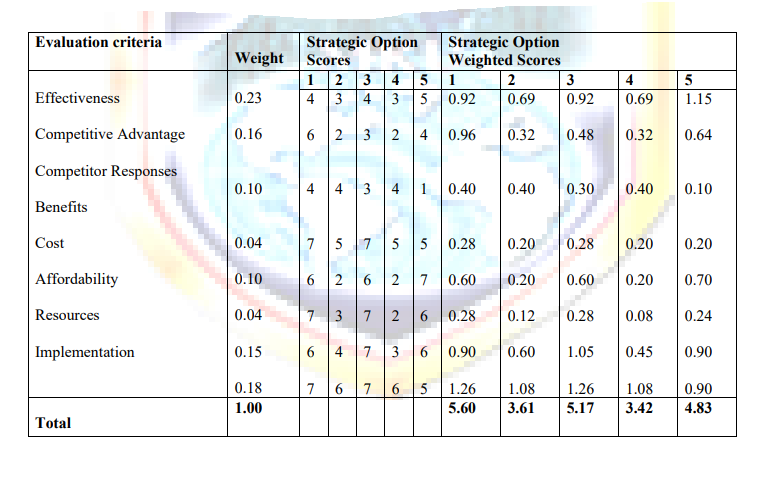
The weights and scores can be generated by any one of the following methods:
- Evaluator‘s judgment
- Brainstorming
- Jury of experts
- Empirical
- After the evaluation, the strategic option(s) with the highest weighted scores can be chosen for implementation. In this illustration, it could be the first strategic option only, or the first and third strategic options together.
Therefore, the best strategies for ensuring that employees would be professionally qualified as desired are:
- Training employees on the job.
- Hiring only qualified people.
- Current employees who were not qualified would be trained on the job, while ensuring that no one who is not qualified would be hired in future.
- If three strategies were needed or possible, the third strategy would be to poach from other airlines people who were already qualified and perhaps more experienced in the airline industry.
- According to the weighted scores, training employees off-the-job and giving training grants and allowances would be bad strategic options.
Discussion questions
• What do you consider to be the possible similarities and differences in the strategic management process in large and small enterprises?
• It has been observed that the there is growing popularity of strategic planning in Kenya today than ever before. What are the possible explanations for this popularity?
ANALYTICAL FRAMEWORKS AND STRATEGIC MANAGEMENT
Professionalism means conforming either to the technical or ethical standards of profession or an occuplion regarded as such. The important role that managers play in modern business organizations requires a professional approach or what is called professionalism in management. Challenges presented by external and internal environment require practitioners who are qualified and professional trained on professional outlook Managerial skills are so important to organizations and society that cannot be ignored. The increasing importance of managerial function requires the managers lo strive for the high standards expected of professionals. Possession of technical ability proficiency in financial management and resources utilization and acquisition of human relations skills go a long way in enhancing effectiveness of a professional manager in today’s environment.
A profile of a professional manager viz nature of his job or overall responsibility and knowledge abilities and skills required to be effective and efficient manager in the changing business environment. The primary responsibilities include examining organizational objectives assessing available resources, their strengths and weaknesses, results to be achieved, remundying deficiencies and designing a strategy of action to achieve the required results. He needs to struck a balance of skills which demand perception and judgment. The professional manager affairs in such a manner that he succeeds in. achieving the tasks set by the Board of Directors. The job of professional manager can be described in the job
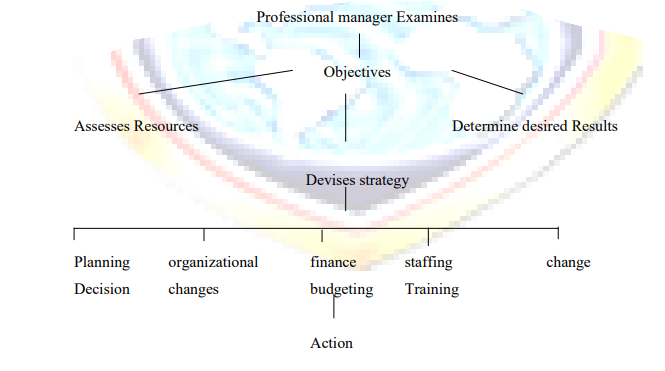
DEVELOPING A STRATEGY
Strategy making involves a few steps
- Identifying specific roles suitable for the company in view of society’s needs and the company resources.
- Integrating various roles with other company efforts to obtain combined effects.
- Expressing the plans interms of targets.
- Setting up sequences and timing of changes.
Developing a strategy and translating it into managerial action requires decision making at each stage.
DETERMINANTS OF STRATEGY
The considerations that affect a strategy are
- Demand for firm’s goods and services
- Supply of services
- Competitive conditions in the industry
- Key success factor
- Growth potentials and profit prospects
- Market strength
- Financial capacity of the management etc
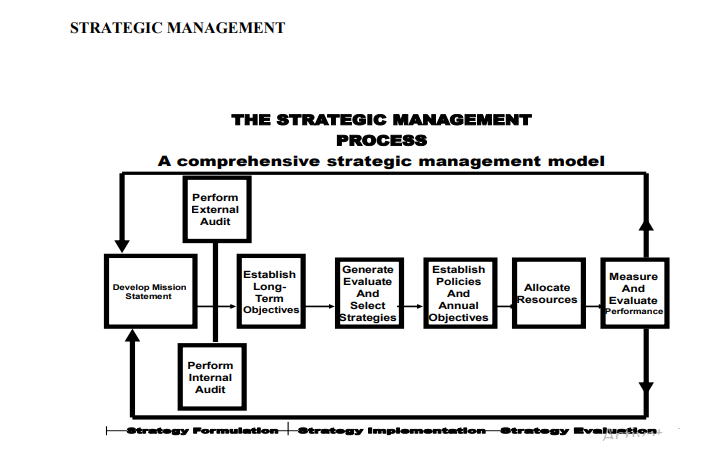
Strategic management as a stream of decisions and actions which leads to the development of an effective strategy or strategies to help to achieve corporate objectives. The end result of strategic management is a strategy or a set of strategies for the
organisation. Strategic management is the process which deals with fundamental organizational renewal and growth with the development of the strategies, structures and systems necessary to achieve such renewal and growth, and with the organizational
systems needed to effectively manage the strategy formulation and implementation process. Firstly this includes two sub-processes within the overall strategic management process. Through the formulation and implementation of sub-processes, the development
of strategies, structures and systems is done to achieve the objectives of organizational renewal and growth of the strategic management process. It is also considered as managing the organizational systems which are required for strategic management. For
instance, the administrative arrangement necessary for formulation and implementation of strategies would also be included in the process of strategic management. In simple words, Strategic Management can also be defined as the formulation and Implementation
of plans and the carrying out of activities relating to the matters which are of vital, Importance or continuing .importance to the total organisation. This is an allen compassing view of strategic management and considers all plans and activities which are Important for an organisation. Strategic management is a systematic approach to a major and increasingly important responsibility of general management: to position and relate the firm to its environment in a way which ensures Its continued success and make
it secure from surprises. The emphasis is on the environment-organisation relationship for the purpose of achieving the objectives of continued success and protection from environmental surprises through the adoption of a systematic approach to general management. Strategic management is defined as the set of decisions and actions resulting in formulation and implementation of strategy. Strategies designed to achieve the objectives of an organisation.
The functions of strategic management can be designed as a set of activities related to the maintenance of an organization in operations. This includes
- Planning for future (developing organizational objectives and purposes).
- Developing organization structure and Developing of Effective information System.
- Motivating people (seeking cooperation from different members of the organization).
- Use of necessary control systems.
- Providing Leadership (Long term survival of the organisation).
Thus, Strategic management is considered as either decision-making and planning, or the set of activities related to the formulation and implementation of strategies to achieve organizational objectives. The emphasis in strategic management is on those general
management responsibilities which are essential to relate the organisation to the environment in such a way that its objectives are to be achieved. This model is widely accepted and comprehensive. Significant improvement in sales, profits and productivity. Allows for identification, prioritization and exploitation of opportunities. Provides an objective view of management problems. Creates a
framework for internal and external communication. It gives encouragement to forward thinking. It gives a degree of discipline and formality to the management of a business. Identification on organizations existing mission, objectives, and strategies is the logical
starting point for strategic management.
Mission statement
Every organization has a mission, objectives, and strategy, even if these elements are not consciously designed, written or communicated. The strategic- management process is dynamic and continous. A change in any one of the major components in the model can necessitate a change in any or all of the other components. Strategists do not go through the process in lock step fashion. Many organizations conduct formal meetings semiannually to discuss and update the firm‘s mission, opportunities/threats,
strengths/weaknesses, strategies, objectives, policies, and performance. These meetings are commonly held off-premises and called retreats. The rationale for periodically conducting strategic-management meetings away from the work site is to encourage more
creativity and condor among participants. Good communication and feedback are needed throughout the strategic management process. A number of different forces affect the formality of strategic management in organizations such as:-
• Size of an organization is a key factor;
• Smaller firms are less formal in performing strategic-management tasks.
• Management styles
• Complexity of production process
• Nature of problems
• Purpose of planning system
• Guides executives in defining the business their firm is in, the end it seeks, and the means it will use to accomplish.
• The strategy formulation process begins with definition of the company mission.
• This is a declaration of an organisation‘s reason for being.
• It answers the pivotal question, ‖what is our business‖
• Sometimes called
• A creed statement
• A statement of purpose
• A statement of philosophy
• A statement of beliefs
• A statement of business principals
• A vision statement
• Characteristically, it is a statement, not of measurable targets but of attitude, outlook and orientation
In general terms, the mission statement addresses the following questions:
- Why is this firm in business?
- What are our economic goals
- What is our operating philosophy in terms of quality, company image, and self-concept?
- What are our core competencies and competitive advantages?
- What customers do and can we serve?
- How do we view our responsibilities to stockholders, employees, communities, environment, social issues, and competitors
A good mission statement describes an organization‘s purpose, customers, products or services, markets, philosophy, and basic technology
Importance of a clear mission
High performing companies have got a more comprehensive mission statement than low performers
Organizations‘ carefully develop a written mission statement for the following
reasons
• To ensure unanimity of purpose within the organisation
• To provide a basis, or standard, for allocating organisational resources
• To establish a general tone or organisational climate
• To serve as a focal point for individuals to identify with the organisation‘s purpose and direction; and to deter those who cannot from participating further in the organizations activities
• To facilitate the translation of objectives into a work structure involving the assignment of tasks to responsible elements within the organisation
• To specify organisational purposes and translation of those purposes into objectives in such a way that cost ,time, and performance parameters can be assessed and controlled
Vision VS Mission
• Some organisations develop both a mission statement and a vision statement.
Wherereas the mission statement answers the question, ‖what is our business‖
The vision statement answers the question, ‖what do we want to become‖
The process of developing a mission statement
• A clear mission statement is needed before alternative strategies can be formulated and implemented
• It is important to involve as many managers as possible in the process of developing a mission statement, because through involvement, people become committed to an organisation.
• A widely used approach is to select several articles about mission statements and ask managers to read these as background information
• Then ask managers to personally prepare a mission statement for the organisation
• A facilitator, or a committee of top managers, should merge those statements into a single document and distribute this draft mission statement to all managers
• A request for modifications, additions, and deletions is needed next, along with a meeting to revise the document
• The process of developing a mission statement represents a great opportunity for strategists to obtain needed support from all managers in the firm
• During the process of developing a mission statement, some organizations use discussion groups of managers to develop and modify the mission statement
• Some organizations hire an outside consultant or facilitator to manage the process and help draft the language.
Fundamental factors to be incorporated in the Mission
• Basic product or service, primary market; principal technology
• Company goals: Survival, Growth, Profitability
• Company philosophy (beliefs, values, aspirations etc.)
• Public image
• Company self-concept (how it relates to its external environment)
• Customers
• Quality
Corporate Social Responsibility
• In defining the company mission, strategic managers must recognize the legitimate rights of the firm‘s claimants
• These include, stakeholders and employees and outsiders affected by the firms actions.
- Customers
- Suppliers
- Governments
- Unions
- Competitors
- Local Communities
- General Public
• Strategic managers can use a continuum that encompasses four types of social commitment
- Economic
- Legal
- Ethical
- Discretionary social responsibility
Economic Responsibilities
• This is the most basic CSR of a business
• The CSR is assured to be providing goods and services to society at a reasonable cost In discharging the economic responsibility; the company also emerges as socially responsible by providing productive jobs for its workforce, and tax payments for its local, state and federal governments.
• Legal responsibilities
Reflects the firms obligations to comply with the laws that regulate business activities
The consumer and environmental movements focused increased public attention on the need for social responsibility in business by lobbying for laws that govern business in the areas of pollution control and consumer safety
Effects of CSR on mission statement
In developing mission statements, managers must identify all stakeholder groups and weigh their relative rights and abilities to affect the firms success Some companies are proactive in their approach to CSR, making it an integral part of their mission statement. Others are reactive, adopting socially responsible behaviour only when they must.
Environmental scanning
The Internal
All strategic managers must have an in-depth understanding of the strategic factors within the organization. These factors are the internal strengths and weaknesses that act to either constrain or support a strategy. The strategic factors in a corporation‘s internal
environment are:-
- Structure
- Culture and
- Resources.
Structure
A structure is a formal arraignment of roles and relationships of people in such a way that work is directed toward the achievement and accomplishment of an organization goals and mission. The structure of any organization is viewed in terms of communication
authority and work flow. There are five types of organization structures
- Simple
- Functional
- Divisional
- Matrix
- Conglomerate
Culture
An organizations culture is the collection of beliefs, expectations and values that are shared by its members and are passed from one generation of employees to another. The result is norms which are rules or codes of conduct that define that behavior is acceptable
from top management to the rank and file. Infact, the behavior of people in an organization is shaped by corporations of the world have distinctive cultures that are somehow responsible for their ability to create, implement, and maintain their world leadership positions.
Resources
On the most practical ways to develop a master strategy of a corporation is to choose particular roles that are appropriate in view of competition and corporations resources. Corporation‘s resources are considered in terms of financial, physical and human,
organizational systems and technological abilities. These resources are normally dealt with under functional areas of marketing, finance, research and development, operations, human resources and information‘s.
External Environment
• This is determined by conducting an external strategic management audit (sometimes called environmental scanning or industry analysis).
• This audit focuses on identifying and evaluating trends and events beyond the control of a single firm.
• An external audit reveals key opportunities and threats confronting an organisation so that managers can formulate strategies to take advantage of the opportunities and avoid or reduce the impact of threats.
External forces can be divided into five broad categories:
• Economic forces
• Social demographic, and environmental forces;
• political, governmental, and legal forces;
• technical forces;
• competitive forces.
• Sources of information
• Key magazines
• Trade journals
• Newspapers
• Collection of primary data through questionnaires
• Suppliers
• Distributors
• Customers
• Competitors
• Universities
• Libraries
• Periodic scanning reports can be submitted to the department concerned, normally strategic planning department or the relevant department
• Once the information is gathered, it should be assimilated and evaluated for decision making
Technological forces
• This is very rapid
• Includes the internet
• W.W.W, EDI, money transfer, etc…
• Help to identify opportunities as well as threats in business Competition, products, market, customers, pricing etc…
• Facilitates efficiency and effectiveness in business transaction
• The organisation must effectively utilize the opportunities availed by the technological forces and minimize the threats
• The organisation must change with the changing technology to remain competitive
Economic forces
• Inflation
• Unemployment
• Availability of Credit
• Level of disposable income
• Propensity of people to spend
• Interest rates
• Economies of scale
• Value of Kshs in world markets
• Foreign countries economic conditions
Social cultural forces
• Social cultural, demographic, and environmental changes have a major impact upon virtually all products, services, markets, and customers
• Small, large, for-profit and non profit companies are affected by threats and opportunities created by the above factors
• Managers must understand the dynamics of this environment and make decisions which will enable the organizations attain their goals and objectives
• In Kenya the scourge of AIDS/HIV pandemic on the productivity of the workforce must be addressed.
• Cultural practices in certain communities must be eliminated
• Tribalism has to be reduced to bare minimum/cohesive nation a must for prosperity
• Population explosion needs to be curbed
• Poverty levels should be monitored
• Shelter
• Literacy levels/Education institutions should be improved and quality education
• Infrastructure
• Health facilities should be improved
• Number of marriages
• Number of divorces
• Number of births
• Immigration and emigration rates
• Social security programmes
• Life expectancy rates
• Per-capita income
• attitudes towards business
• Lifestyles
Political forces
• Central government, local and foreign governments are major regulators, deregulators, subsidizers, employers, and customers of organizations
• Political, governmental, and legal factors can therefore represent key opportunities or threats for both small and large organizations
• Government regulations and deregulations
• Change in tax laws
• Voters participation rates
• Level of defense expenditures
• Legislation on equal employment
• East African Community
• Relationship between Kenya, Tanzania, Uganda
• Movement of people across the borders
• Size of government budgets
• Location and severity of terrorist activities
• General election impact on the people, policy and economy.
Establish long term objectives
The strategic management is the major vehicle for planning and implementing major changes an organization makes. Many organizations tend to spend substantial amount of time and effort in developing the strategic plan, without devoting sufficient attention to the means and circumstances under which the strategic plan to be implementation has often been seen that changes come through the implementation. Though strategic management begins with strategic planning, the other components are no less important.
About the implementation of strategic plans, the need (or proper corporate culture, organization structure and appropriate policies regarding appraisal need to be stressed. Strategic Management is a stream of decisions and actions with a view to develop an
effective strategy (or strategies) which would help the organization achieve its Corporate goals. Strategic management involves strategic analysis. Strategic choice making and strategic implementation strategies exist at all levels-Corporate level business level and
operational level. There is a need for strategic vision for strategic managers and the benefits of strategic management.
The strategic management process is the way in which strategists determine objectives and make strategic decisions. In the management of business in earlier times, the focus of the manager’s job was on decision for today’s world in today’s business. This approach may have been satisfactory then. However, the changes that have been taken place over a period of time in the environment have led to the need for a different approach to management Instead of focusing all their time on today’s problems, the managers began to see the value of trying to anticipate the future and to prepare for it. They did this in several ways. One way vas to evolve systems and prepare manuals (or procedures) for decisions which are routine and repetitive in nature as this allowed more time for
important decisions. Another way was to prepare budgets and thereby anticipate future sales and flow of funds.
Long range planning
These things helped, but they tended to be based on the present business and its present conditions and as such these mechanisms could not deal well with the change‘s by themselves. The lack of emphasis on future in budgeting led to long range planning. Long
range planning focused on forecasting the future by using economic and technological tools. The formulation of these plans has bean the responsibility of corporate staff group, whose reports forwarded lo top management. The top management could approve,
disapprove or modify these plans. However, the corporate planners ware not the decision makers.
Long range planning had some impact, but not as much as would be expected if the top management were involved. Moreover, the corporate planners were producing what can be termed “first-generation plans”. First-generation planning means the firm chooses the
most probable appraisal of the future environment and of its own strengths and weaknesses. From this, ‘it evolves the best possible strategy for a match of the environment and plan for the most likely future.
Modern approach is called “strategic planning.” The top management, including the board of directors and corporate planners have important roles to play in strategic management. But the starting roles are for the general managers of the corporation and its
major operating divisions. Strategic management focuses on analysis thus strategies are then prepared for each of these likely future scenarios.
Generate, evaluate and select strategies
Interaction of organization with its environment in the light of its strengths and weaknesses results into various strategic alternatives. This process may result in to large number of alternatives through which an organization can relate itself to the environment.
However, all alternatives can not be chosen even if all of them produce the same results. Obviously managers may like to limit themselves to the serious consideration of some of the strategic alternatives so that they are saved from unnecessary exercise. Therefore, the strategic alternatives to be identified in the light of strategic opportunities and threats generated through environmental analysis, and organizational mission and objectives.
The identification of various strategic alternatives leads to the level when managers consider some alternatives serious/y and may choose one of the most acceptable. This is the stage of strategic decision process and all factors for decision making are relevant.
Since the particular strategy attempts to affect the organizational operation in some predetermined manner, the choice process systematically considers how each alternative strategy affects the various critical factors of the organizational functioning. Further, the
chosen alternative to be acceptable in the light of organizational objectives. Thus, it is not necessary that the chosen alternative is the best one. In the choice process, apart from the various organizational and environmental factors, personal factors play considerable role because choice of strategy reflects the personal values and aspirations of strategist.
Establish policies and annual objectives
Annual objectives serve as guidelines for action, directing and channelling efforts and activities of organizational members. They serve as standards of performance and as such give incentives for managers and employees to perform. They provide a basis for organizational design. Annual objectives are essential for strategy implementation because they:
- Represent the basis for allocating resources;
- Are primary mechanism for evaluating managers;
- Are the major instruments for monitoring progress toward achieving longterm objectives; and
- Establish organizational, divisional and departmental priorities.
Annual objectives translate long-range aspirations into this year‘s targets. Annual objectives should be consistent across hierarchical levels and form a network of supportive aims. They should be:
- Measurable,
- Consistent,
- Reasonable,
- Challenging,
- Clear,
- Communicated throughout the organization,
- Characterized by an appropriate time dimension, and
- Accompanied by commensurate rewards and sanctions.
They should be compatible with employees‘ and managers‘ values and should be supported by clearly stated policies
Policies
Policies are specific guidelines, methods, procedures, rules, forms, and administrative practices established to support and encourage work towards stated goals. They are broad, precedent-setting decisions that guide or substitute for repetitive managerial decision-making. Therefore, they are directives designed to guide the thinking, decisions, and actions of managers and their subordinates in implementing a firm‘s strategy. Policies set boundaries, constraints and limits on the kind of administrative actions that can be taken to reward and sanction behaviour. They clarify what can and cannot be done in pursuing of an organization‘s objectives. Policies let both employees and managers know what is expected of them, thereby increasing the likelihood that strategies will be implemented successfully. Whatever their scope and form, policies serve as a mechanism for implementing strategies and achieving objectives. Policies represent the means for carrying out strategic decisions and hence should be stated in writing whenever possible.
Functional strategies
They are the shot-term activities that each functional area within a firm must undertake in order to implement the grand strategy. Functional level strategy primarily focuses on achieving maximum use of resources i.e attaining maximum resources productivity.
Functional strategies address issues regarding the coordination and integration of activities within a single function. They must be consistent with both short and long-term objectives.
Allocate resources
Once the creative and analytical aspect en strategy formulation has been decided, the organization tries to convert the strategy into something operationally effective. To bring the result toe strategy to be put to action because mere choice of even the soundest
strategy may not lead to its objectives. In strategy implementation, various activities involved are design of organization structure to suit the chosen strategy, effective leadership, development of functional policies, allocation of resources, development of
effective information system and use of control system, etc.
Measure and evaluate
Review and control may be treated as the fast stage of strategic management process. However, this is an on-going process and review and control to be taken as the process for the future course of action. For effective implementation and consequently achievement of organizational objectives, it is necessary that there is continuous monitoring of the implementation of the strategy so that suitable action is taken whenever something goes wrong.
Review and control of strategy and its implementation may result into various actions that the organization has to take to be successful depending on the situation. Such action may be required in the area of correcting implementation of strategy, choice of strategy
or change in organizational mission and objectives and consequently leading to change in that identification of strategy. Therefore, strategic management process be taken as dynamic so that new action is taken whenever there is any change in any of the factors
affecting strategy.
Factors to consider in strategy formulation
- The most important outcome from successful strategy implementation is real value added through goal achievement and increased stakeholders satisfaction.
- Successful strategy implementation depends on various factors.
- For effective strategy implementation, there must be congruence between several
elements: organization structure, culture (shared values), resource (budget) allocation, staff competencies and capabilities, support systems, reward systems, policies and procedures, and leadership style. - Organizational structure is the formal framework by which job tasks are divided, grouped, and coordinated.
- It helps people pull together in their activities that promote effective strategy implementation.
- The structure of an organization should be compatible with the chosen strategy and if there is incongruence, adjustments will be necessary either for the structure or the strategy itself.
- For a successful strategy implementation, a supporting organization structure is critical.
- Positioning of the functions in the organization structure sets more focus on key functions whose performance is critical to the success of a firm‘s strategy and institutionalizes the decision making of the heads of these functions.
- When the business strategy changes, organization structure is received in light of the changes in strategy to maintain the relevance of the structure.
Organizational culture is a system of shared meaning and beliefs held by organizational members that determines, to a large degree on how they act. It provides the social context in which an organization performs its work. It guides the organization‘s members in: Decision making, Determining how time and energy are invested, and Deciding which options are looked on favourably from the start and which types of people are selected to work for the organization. It is the strategy implementer‘s task to bring the corporate culture into alignment with the strategy and keep it there once a strategy is chosen. Culture can either be a strength or a weakness. As strength, culture can facilitate communication, decision-making, and control, and can create co-operation and commitment. As a weakness, culture may obstruct the smooth implementation of strategy by creating resistance to change. Organizations have at least four types of resources that can be used to achieve desired objectives, namely:
- Financial resources,
- Physical resources,
- Human resources, and
- Technological resources.
It is possible to implement a strategy with the resources available but impossible to implement a strategy which requires more resources than can be made available. Innovative state-of-the-art support systems can be a basis for competitive advantage if they give firm capabilities that rivals can‘t match. Strategy implementation is also affected by how well policies and operating procedures that aid the task are prescribed. New or revised policies and procedures provide top-down guidance to operating managers, supervisory personnel and employees regarding how certain things need to be done and what behaviour is expected. Responsibility for strategy implementation should be clearly defined. The ―How‖ of allocating responsibility is also important. Roles played are determined by the nature of institutional structures that are in place:
- The Board
- Top Management Team
- Middle Management
- Operational Staff
VALUES
We all know that as part of best practices, virtually all institutions whether public, private, educational, faith-based or civil society oriented have clearly outlined sets of values in their strategic plans and service charters. Most of these values are usually displayed prominently in the entrance foyers, boardrooms, waiting rooms and literally in all the offices.
But a number of questions beg some answers:-
- Firstly, do the leaders and the persons in these institutions appreciate these values?
- Secondly, if the answer is yes, then why are the values not put in practice?
- Thirdly, what steps ought to be taken to ensure that these stated values are institutionalized and fully practiced?
- Fourthly, what measures and what reforms are required to ensure the internalization of these values?
- Finally, how can we regularly assess whether these values are being practiced by all and whether the intended results are being achieved?
Values are important in that they exert influence on the way people relate with each other, as well as the way people serve and engage with other communities. Indeed, the values of a people determine how the people are viewed and assessed by others. And finally, values define a people‘s identity, including who they are, what they believe in, what they stand for and how others perceive and view them.
Values are derived from a variety of sources; however, the vast majority is derived from various culture, religions, and contact with other societies, rules, regulations and laws. In Kenya, the case is that the values are neither codified in a policy document or in a manner that the citizens can clearly say what constitutes the national values.
Kenya is a multi-ethnic and multi-racial country. As a nation we may talk of a national culture, one that unites us as one nation. In reality, however, the multi-ethnic nature of the country means that we have literally as many cultures as we have ethnic groups. On
the other hand, we can say that on account of western education, urbanization and developments in communication, there is much less distinction nowadays in the different ethnic cultures than there was at the time of colonization.
We all know that life is a complex phenomenon and that any way of life is made up of innumerable facets. To most anthropologists, culture encompasses the learned behaviours, beliefs, attitudes, values and ideals that are characteristic of a particular society or population1 Thus, all human beings are born in a complex culture which strongly influences how they live and behave throughout their lives. From the above definition of culture, we see that values constitute one aspect of culture. In everyday usage, the word ―value‖ refers to the intrinsic worth, the fair equivalent or goodness of something. In philosophy, on the other hand, ―value‖ deals with the notion of the good in the widest sense, embracing not only the morally good but also the beautiful and the true.
In traditional Kenyan cultures, people valued the institution of marriage, human life, morality, respect for people’s property, and good leadership. This list is not exhaustive. There were many things that different cultures valued but which may not have been
looked at in the same way by other cultures. Our interest here is with those things that had ―universal‖ value across the different cultures. Let us now examine each of these universal values.
Marriage
The institution of marriage was highly valued by all the traditional cultures in Kenya. To a large extent, especially in the rural areas, it is highly valued even today. The reason for this is that marriage is the foundation on which families are built. On its part, the family
constitutes the basic social group that operates most widely and most intensely in the activities of everyday life. All kinship relationships ultimately derive their legitimacy from the family. The rights and duties of the individual-economic, religious and political life either exclusively or predominantly work through channels of kinship.
The individual who wishes to obtain a maximum degree of protection by the community in which he lives and to attain influence and prestige in it must aim at securing for himself a prominent place in the elaborate network of kinship relations. This he can do
only through marriage and protection, for matrimony and parenthood are necessary steps in the process of acquiring social status.
Marriage, therefore, had the specific purpose of perpetuating one’s lineage and–in the process– bestowing social status on man. Thus, in general pre-marital sex was discouraged since it did not serve the purpose of matrimony and parenthood. Stiff fines were meted out to people who committed adultery, as we shall see later on.
Human Life
Human life is highly valued in the modern world. This was no different among the traditional Kenyan communities. However, it was permissible to kill an enemy, just as is the case today. In all other cases, no one was allowed to take away another person’s life.
In fact, no distinction was made between murder and manslaughter; both were considered murder. Murder was punished according to the principle of compensation.
Morality
Morality is a quality that was highly valued by all traditional cultures in Kenya. Indeed, moral values formed the bedrock of the education that was given to children as they grew up. Moral values were also impressed on people who were about to wed or who were
going through one rite of passage to another. Leaders were also expected to be people of upright character.
Respect for Other People’s Property
Children were traditionally socialized to respect other people’s property. Through rewards and punishments, the children grew up distinguishing between legitimately acquired goods and stolen ones. Each family endeavoured to ensure that their children respected
their neighbours‘ properties. The idea was to inculcate in the minds of the young the virtue of honesty.
Good Leadership
In any culture leadership is considered a very important institution. This is because leadership tends to influence, if not to dictate, all the activities and affairs of that culture. Thus, traditional cultures in Kenya attached great importance to the qualities of good
leadership. This is in spite of the fact that almost all these cultures did not have centralized systems of government. At whatever level of leadership, whether as individuals or members of councils of elders, the leaders had to possess certain qualities that were acceptable to the people as characteristics of good leadership. These qualities included seniority in age, wealth, reputation as a warrior and other characteristics of leadership.
Some of the values an institution can embrace are:-
- Punctuality – Speed and respect for time; a country in hurry
- Spirit of Service – Customer service mentality; constant improvement and anticipation
- Quality of Delivery – High standards, spirit of excellence, efficiency
- Result Oriented – completion towards results; we finish what we start
- Self Respect – National pride
CORPORATE CULTURE
Change in any institution starts with leadership of an institution. We shall therefore look at leadership and Hofstede‘s cultural dimensions.
Hofstede’s Cultural Dimensions
Power Distance Index (PDI) focuses on the degree of equality, or inequality, between people in the country’s society. A High Power Distance ranking indicates that inequalities of power and wealth have been allowed to grow within the society. These societies are more likely to follow a caste system that does not allow significant upward mobility of its citizens. A Low Power Distance ranking indicates the society de-emphasizes the differences between citizen’s power and wealth. In these societies equality and opportunity for everyone is stressed. Individualism (IDV) focuses on the degree the society reinforces individual or collective achievement and interpersonal relationships. A High Individualism ranking indicates that individuality and individual rights are paramount within the society. Individuals in these societies may tend to form a larger number of looser relationships. A Low Individualism ranking typifies societies of a more collectivist nature with close ties between individuals.
These cultures reinforce extended families and collectives where everyone takes responsibility for fellow members of their group.
Masculinity (MAS) focuses on the degree the society reinforces, or does not reinforce, the traditional masculine work role model of male achievement, control, and power. A High Masculinity ranking indicates the country experiences a high degree of gender
differentiation. In these cultures, males dominate a significant portion of the society and power structure, with females being controlled by male domination. A Low Masculinity ranking indicates the country has a low level of differentiation and discrimination
between genders. In these cultures, females are treated equally to males in all aspects of the society.
Uncertainty Avoidance Index (UAI) focuses on the level of tolerance for uncertainty and ambiguity within the society – i.e. unstructured situations. A High Uncertainty Avoidance ranking indicates the country has a low tolerance for uncertainty and
ambiguity. This creates a rule-oriented society that institutes laws, rules, regulations, and controls in order to reduce the amount of uncertainty. A Low Uncertainty Avoidance ranking indicates the country has less concern about ambiguity and uncertainty and has
more tolerance for a variety of opinions. This is reflected in a society that is less ruleoriented, more readily accepts change, and takes more and greater risks.
Long-Term Orientation (LTO) focuses on the degree the society embraces, or does not embrace, long-term devotion to traditional, forward thinking values. High Long-Term Orientation ranking indicates the country prescribes to the values of long-term
commitments and respect for tradition. This is thought to support a strong work ethic where long-term rewards are expected as a result of today’s hard work. However, business may take longer to develop in this society, particularly for an “outsider”. A Low Long-Term Orientation ranking indicates the country does not reinforce the concept of long-term, traditional orientation. In this culture, change can occur more rapidly as longterm traditions and commitments do not become impediments to change.
The Nature of Leadership
Leadership
The process by which a person exerts influence over others and inspires, motivates and directs their activities to achieve group or organizational goals.
Effective leadership increases the firm‘s ability to meet new challenges.
Leader
An individual who is able to exert influence over other people to help achieve group or organizational goals.
Personal Leadership Style
The specific ways in which a manager chooses to influence others shapes the way that manager approaches the other tasks of management. Leaders may delegate and support subordinates, while others are very authoritarian. The challenge is for managers at all
levels to develop an effective personal management style.
Leadership Across Cultures
Leadership styles may vary among different countries or cultures. European managers tend to be more people-oriented than American or Japanese managers. Japanese managers are group-oriented, while U.S managers focus more on profitability. Time horizons also are affected by cultures.
• U.S. firms often focus on short-run efforts and results.
• Japanese firms have a longer-run perspective.
• European firms fall somewhere between the U.S. and Japanese orientations.
Contingency Models of Leadership
Fiedler’s Model
Effective leadership is contingent on both the characteristics of the leader and of the situation. Leader style is the enduring, characteristic approach to leadership that a manager uses and does not readily change.
• Relationship-oriented style: leaders concerned with developing good relations with their subordinates and to be liked by them.
• Task-oriented style: leaders whose primary concern is to ensure that subordinates perform at a high level so the job gets done.
Situation Characteristics
- How favorable a situation is for leading to occur.
- Leader-member relations—determines how much workers like and trust their leader.
- Task structure—the extent to which workers tasks are clear-cut; clear issues make a situation favorable for leadership.
- Position Power—the amount of legitimate, reward, and coercive power leaders have due to their position. When positional power is strong, leadership opportunity becomes more favorable.
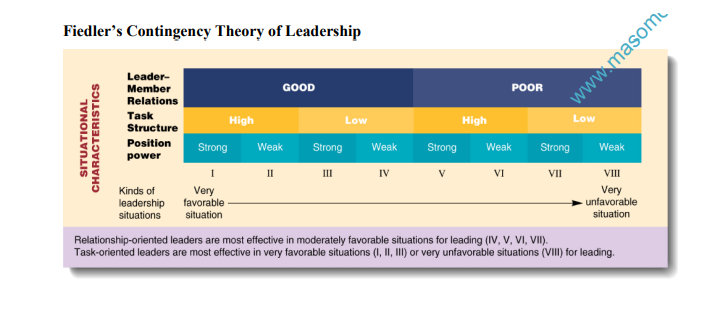
House’s Path-Goal Theory
• A contingency model of leadership proposing the effective leaders can motivate subordinates by:
1. Clearly identifying the outcomes workers are trying to obtain from their jobs.
2. Rewarding workers for high-performance and goal attainment with the outcomes they desire
3. Clarifying the paths to the attainment of the goals, remove obstacles to performance, and express confidence in worker‘s ability.
Motivating with Path-Goal
• Path-Goal identifies four leadership behaviors:
1. Directive behaviors: set goals, assign tasks, show how to do things.
2. Supportive behavior: look out for the worker‘s best interest.
3. Participative behavior: give subordinates a say in matters that affect them.
4. Achievement-oriented behavior: Setting very challenging goals, believing in worker‘s abilities.
• Which behavior to be used depends on the nature of the subordinates and the tasks.
The Leader Substitutes Model
• Leadership Substitute
1. Acts in the place of a leader and makes leadership unnecessary. Possible substitutes can be found in:
• Characteristics of the subordinates: their skills, experience, motivation. • Characteristics of context: the extent to which work is interesting and fun.
2. Worker empowerment or self-managed work teams reduce leadership
needs.
3. Managers should be aware that they do not always need to directly exert influence over workers.
Transformational Leadership
• Leadership that:
- Makes subordinates aware of the importance of their jobs and performance to the organization by providing feedback to the worker.
- Makes subordinates aware of their own needs for personal growth and development.
- Motivates workers to work for the good of the organization, not just themselves.
Being a Charismatic Leader
Charismatic Leader is an enthusiastic, self-confident transformational leader able to clearly communicate his or her vision of how good things could be by:
• Being excited and clearly communicating excitement to subordinates.
• Openly sharing information with employees so that everyone is aware of problems and the need for change.
• Empowering workers to help with solutions.
• Engaging in the development of employees by working hard to help them build skills.
Transactional Leadership
Transactional Leaders
- Use their reward and coercive powers to encourage high performance— they exchange rewards for performance and punish failure.
- Push subordinates to change but do not seem to change themselves.
- Do not have the ―vision‖ of the transformational leader.
From a global perspective, in Singapore leaders built capacity in the people through:-
- Human Resource Investments
- Strategic Educational Subsidies & Grants
- Generous Merit Scholarships
- Strategic Housing Subsidies
- Skills Development Fund (SKF)
- Strategic Health Subsidies: A,B,C wards
- Infra-Structure Investments: supply chain
- Low Personal Income Taxes & No Death Tax
- Re-distribution of Wealth: No Capital Gain Tax
- Scouting for next generation Leaders
- Sympathetic Social Welfare Department
How to inculcate values and an ethical culture of integrity
- National leaders‘ commitment to national core values
- societal change-agents & leaders mobilized
- government leaders
- business leaders
- educational leaders (teachers)
- media leaders
- sports & performing arts leaders
- religious leaders
- family (parents)
Definition: Corporate culture is an idea in the field of organizational studies and management which describes the psychology, attitudes, experiences, beliefs and values (personal and cultural values) of an organization. It has been defined as “the specific collection of values and norms that are shared by people and groups in an organization and that control the way they interact with each other and with stakeholders outside the organization.”
Definition: Corporate values, also known as “beliefs and ideas about what kinds of goals members of an organization should pursue and ideas about the appropriate kinds or standards of behavior organizational members should use to achieve these goals. From
organizational values develop organizational norms, guidelines, or expectations that prescribe appropriate kinds of behavior by employees in particular situations and control the behavior of organizational members towards one another. The three structural levels of any culture from Alan Price (2007) Human Resource Management in a Business Context (3rd Edition)
Value
The value acts as the roots of all culture which provides the organisation with both stability and solidity. It also helps in sustaining the organisation the values are put as the roots of tree.
Institutions
The institution includes formal or informal where the values and the beliefs take shape in a diverse area of experience, structuring the behavior and the ways of acting of the members of the society in question. This is achieved by offering a frame work in which the values take shape in different area of experience. The institutions are the trunk of a tree.
Practices
This is formal by particular practices which provide physical and evident dimensions from the outside of the culture in question. The practices act as the branches of a tree which can experience very important changes which help the culture to be maintained.
For us to be able to maintain culture we need to have strong roots (myths, beliefs and values) which need to be developed in whole (structure and strong practices). For any organisation to survive globally, it needs to be visible by looking at the different elements
that shapes all the culture, practices together with institution.
Types of organizational culture
Organizational culture can vary in a number of ways. It is these variances that differentiate one organisation from the others. Some of the bases of the differentiation are presented below :
Strong vs weak culture:
Organizational culture can be labeled as strong or weak based on sharedness of the core values among organizational members and the degree of commitment the members have to these core values. The higher the sharedness and commitment, the stronger the
culture increases the possibility of behaviour consistency amongst its members, while a weak culture opens avenues for each one of the members showing concerns unique to themselves. Strong culture is said to exist where staff respond to stimulus because of their
alignment to organizational values. In such environments, strong cultures help firms operate like well-oiled machines, cruising along with outstanding execution and perhaps minor tweaking of existing procedures here and there.
Soft vs hard culture:
Soft work culture can emerge in an organisation where the organisation pursues multiple and conflicting goals. In a soft culture the employees choose to pursue a few objectives which serve personal or sectional interests. A typical example of soft culture can be found in a number of public sector organizations in India where the management feels constrained to take action against employees to maintain high productivity. The culture is welfare oriented; people are held accountable for their mistakes but are not rewarded for good performance.
Consequently, the employees consider work to be less important than personal and social obligations. Sinha (1990) has presented a case study of a public sector fertilizer company which was established in an industrially backward rural area to promote
employment generation and industrial activity. Under pressure from local communities and the government, the company succumbed to overstaffing, converting mechanized operations into manual operations, payment of overtime, and poor discipline. This resulted in huge financial losses (up to 60 percent of the capital) to the company.
Formal vs informal culture :
The work culture of an organisation, to a large extent, is influenced by the formal components of organizational culture. Roles, responsibilities, accountability, rules and regulations are components of formal culture. They set the expectations that the organisation has from every member and indicates the consequences if these expectations are not fulfilled
Elements of organizational culture
These elements may overlap. Power structures may depend on control systems, which may exploit the very rituals that generate stories which may not be true.
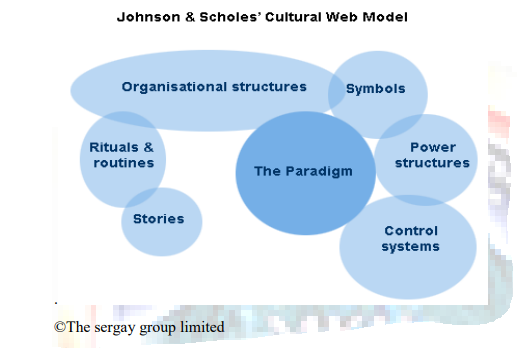
The cultural web contains 6 inter-related elements:
Rituals and routines – are concerned with the day-to-day behavior of people in the organisation e.g. the way customers are dealt with or the existence of privileges for certain staff. They are things that are taken for granted by existing staff but have to be
learned by new people. They often present significant barriers to change, if people are protective of their ‘customs’. Rituals such as training programmes or personnel procedures can reinforce the perception of how things are done, and demonstrate to staff
what behavior is desirable and valued by senior management.
Stories – within the company focus upon past events in the organisation and are told to people both outside and inside the organisation. They communicate something of the organization‘s culture. Company ‘heroes’, such as charismatic leaders of the past, and mavericks can be perceptions of ‘normal’ behavior.
Symbols. – Logos, language, status symbols e.g. company cars; office carpets etc can all provide a visible reflection of company culture.
Power structures. – Directors and senior managers, or groups of directors and senior managers with the most power, are likely to have the most influence.
Organizational structure. – Both the formal structure (as found on the organisation chart) and the informal structure are likely to reflect power structures and play an important part in influencing the core values of an organisation.
Control systems – the measurement and reward systems used in the organisation There are a number of behaviorally focused tools, such as Corporate culture Inventory, which look at the culture through the behaviors‘ of the managers and leaders. These can
provide a platform for identifying what development is required to move towards a positive, performance culture. However, it does not necessarily focus on business oriented outcomes, but more on the personal criteria.
Importance of organizational subculture
Sub cultures are minicultures within an organisation. These minicultures operate within the larger, dominant culture. Subcultures are usually an outcome of occupational, professional, functional differences or geographical distance.
Types of organizational Sub culture.
- Academy
Organizations with this kind of a culture hire new college graduates and train them in a wide variety of jobs. Such an organisation culture provides the employees with opportunities to master different jobs. - Club
Organizations that are highly concerned with getting people to fit in and be loyal are referred to as a club the organisation promotes form within and highly value seniority. - Baseball teams
In such cultures employees tend to be entrepreneurs who are willing to take risks and are handsomely rewarded for their success. This type of culture exists in fast paced high risk organizations such as an investment banking, advertising. - Fortress
The fortress type of culture exists in organisations that are facing a hard time in fighting for the survival. Employees who enjoy the challenges of fighting with their backs against the wall and do not mind the lack of job security enjoy working in this kind of culture.
Categories of artifacts through which corporate culture is communicated.
Artifacts are the observable symbols and signs of an organization‘s culture, such as the way visitors are greeted, the physical layout, and how employees are rewarded. ―You show your corporate culture in everything—the way the building looks, the way people act, the names of the conference rooms,‖ said Joe Kraus, a cofounder of Excite, an
Internet gateway
We look at four broad categories of artifacts: organizational stories and legends, rituals and ceremonies, language, and physical structures and symbols.
Organizational stories and legends
Many years ago, so the story goes, a security guard stopped IBM CEO Thomas Watson, Jr., as he was about to enter an area without his identification badge. Watson explained who he was, but the guard insisted that a badge must be worn in secured areas of the
building. Rather than discipline the guard, Watson praised him and used this experience to tell others about performing their job well. Stories and legends like this about past corporate incidents serve as powerful social prescriptions of the way things should (or
should not) be done. They provide human realism to individual performance standards and use role models to demonstrate that organizational objectives are attainable. This IBM‘s story advises employees to obey rules
Rituals and ceremonies
Rituals are the programmed routines of daily organizational life that dramatize the organization‘s culture. Rituals include how visitors are greeted, how often senior executives visit subordinates, how people communicate with each other, how much time employees take for lunch, and so on. Ceremonies are more formal artifacts than rituals. Ceremonies are planned activities conducted specifically for the benefit of an audience. This would include publicly rewarding (or punishing) employees, or celebrating the launch of a new product or newly won contract.
Language
The language of the workplace speaks volumes about the company‘s culture. Language also highlights values held by organizational subcultures. Corporate culture might also be represented in the phrases, metaphors, and other special vocabularies used by
organizational leaders.
Physical structures and symbols
Physical structures and spaces, such as British Airways‘ the Red Cross, often symbolize the company‘s underlying values and beliefs.28 The size, shape, location, and age of buildings might suggest the organization‘s emphasis on teamwork, risk aversion, flexibility, or any other set of values.
Culture supplements rational management:
Creation of an appropriate work culture is a time – consuming process. Therefore, organisation culture cannot suddenly change the behaviour of people in an organisation. A number of management tools are used to channelize the behaviour of people in a
desired way. No change can be effectively brought about without involving people. Culture communicates to people through symbols, values, physical settings, and language, and hereby supplementing the rational management tools such as technology and structure.
Culture facilities induction and socialization:
Induction is a process through which new entrants to an organisation are socialized and indoctrinated in the expectation of the organisation; its cultural norms, and undefined conduct. The newcomer imbibes the culture of the organisation which may involve changing his/her attitudes and beliefs to achieving an internalized commitment to the organisation. Different organizations follow different practices for induction. Gillette India has a system of online induction which enables an IT – savvy newcomer to pick and
choose the areas where he/she needs more detailed information. Bureaucratic organizations, however, spend considerable time explaining rules and procedures during induction as following rules is one of the major requirements of such organizations. Central government organizations in India have a one – year probation training – cum – induction involving cultural training. On the other hand, younger and entrepreneurial organizations are less formal in their induction process. Here, the established senior members share with the newcomers stories of heroes, founders, and charismatic team leaders with vision.
Culture promotes code of conduct:
A strong in an organisation explicitly communicates accepted modes of behaviour are accepted and others would never be visible. The presence of a strong culture would be evident where members share a set of beliefs, values, and assumptions which would influence their behaviour in an invisible way. Where culture has been fully assimilated by people they persistently indulge in a typical bahaviour in a spontaneous way. Promotion of the culture of quality can help achieve good business results. Rohmetra (2000) conducted a study of cultural diversity and ethical behaviour. She collected data from 30 managers of Dogra culture and 35 managers of Laddakhi
culture. Her results showed that Dogra managers had highest consistency between what they believe and what they do at work, while the situation was the reverse for Laddaakhi managers.
Subcultures contribute to organisational diversity:
Sub – cultures, and sub -systems of values and assumptions which may be based on departmentalization, activity centers, or geographical locations, provide meaning to the interests of localized, specific groups of people within the macro organisation. Sub –
cultures can affect the organisation in many ways:
- they may perpetuate and strengthen the existing culture;
- They may promote something very different from those existing;
- They may promote a totally opposite sub – culture (beliefs and values) or counter culture when in a difficult situation.
Care needs to be exercised when promoting a counter culture as it may be detrimental to the larger organizational interest.
Gives members an organisational identity, in other words, attracts develop and keep talented people. Serve as a magnet. A feeling of
belonging exists among employers.
Facilitates collective commitment. People own the company, are prepared to give of themselves. Salaries are high, dividends are
high productivity is high.
Promote social system stability, strict standards – tight controls more than just discipline – a mystique. Low turnover. Passionate
commitment to work hard – strong identification with the company.
Shapes behavior by helping members to make sense of their surroundings. (Corporate culture– social glue).
Conditions under which cultural strength improves corporate performance
Does corporate culture affect corporate performance? Ken Iverson, CEO of Nucor Steel is a stunning success story, thinks so. Many writers on this subject generally, argue that culture serves three important functions. First, social control Second, corporate culture is the ―social glue‖ that bonds people together and makes them feel part of the organizational experience. Finally, corporate culture assists the sense-making process. It helps employees understand organizational events.
A strong culture thus is better than a weak one. A strong Corporate culture exists when most employees across all subunits hold the dominant values. The values are also institutionalized through well-established artifacts, thereby making it difficult for those
values to change. Strong cultures are long lasting. In many cases, they can be traced back to the beliefs and values established by the company‘s founder. This makes the company more successful than the one with a weak culture.
Companies have weak cultures when the dominant values are short lived, poorly communicated, and held mainly by a few people at the top of the organization. However strong culture increases organizational performance only when the cultural content is appropriate for the organization‘s environment Companies that operate in a highly competitive environment might be better served with a culture that engenders efficiency. Companies in environments that require dedicated employees will be more successful with an employee-oriented culture. A second concern is that a company‘s culture might be so strong that employees focus blindly on the mental model shaped by that culture.
